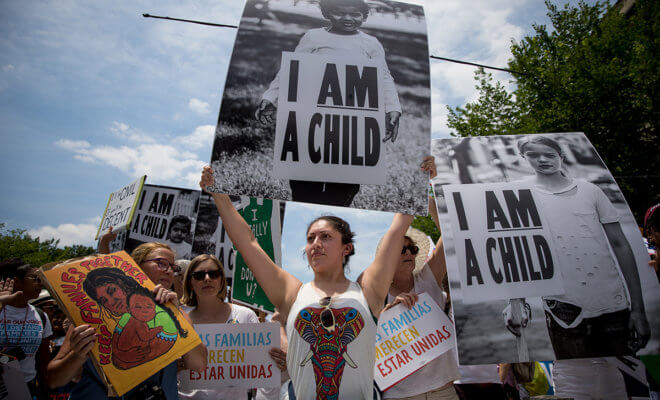Arts
‘I Am a Child’: How An Artist Turned Civil Rights Imagery Into a Message Of Protest For Immigrant Kids

Sufia Bassett, 32, of Bethlehem, Pa., originally from Ecuador, protests against family separation Sunday in Lafayette Square in Washington, D.C.
Photo for The Washington Post by Evelyn Hockstein
On the first weekend of June, 40 children lined up on the front steps of the New York offices of U.S. Immigration and Customs Enforcement holding picket signs in their small hands.
On each, the same message: “I Am a Child.”
An homage to the 1968 “I Am a Man” protest led by Martin Luther King Jr., the signs were meant to send a message to lawmakers who, creator Paola Mendoza said, seemed to have lost sight of the fact that children crossing the U.S.-Mexico border with or without their parents were still, in fact, children.
“I wanted to humanize these children because the only way this unconscionable treatment continues to happen is when these children are dehumanized,” Mendoza said. “And we’ve seen the president do that, calling them or their families animals and criminals and gang members and rapists. We’ve seen Attorney General [Jeff] Sessions talk about smuggling children like drugs, like they’re not people. So it was important to me to remind all adults, no matter what your political ideology is that these are children. That’s it. They’re children. And they have a human right to stay with their parents.”
This message – and the photographs taken by Kisha Bari – was front and center at the mass immigration protest that brought thousands to Washington on Saturday and many more to similar marches around the country organized to oppose the Trump administration’s “zero-tolerance” crackdown on migrants at the U.S.-Mexico border.
There were children everywhere. Little children seated on the shoulders of their mothers and fathers. Infants wearing onesies scrawled with political messages. Older children sprinting through the spray of a fire hose opened up to ease the sweltering heat.
Some of them carried Mendoza’s signs in Washington as they walked with their families the nearly two miles from Lafayette Square to the Justice Department.
“When you create a piece of art, you’re never sure what the impact will be. But for me, I create it because it’s something that keeps me up at night and it’s something that gets stuck in my head or my heart,” said Mendoza, who attended the march on Saturday with her 5-year-old son, Mateo. “Seeing it there at the front of the march, I just felt like finally. It was so powerful to see all different kinds of American people come out and say, ‘We care about this.’ And I felt especially proud that parents brought their own children to be a part of this moment.”
Drawing inspiration from history was something Mendoza said she relied on in creating the “I Am a Child” photographs and also in her role as director for Saturday’s rally. She said she hopes looking to the past will help guide the country back to its “moral center.”
The “I Am a Man” protest took place in Memphis, Tennessee, when as many as 1,300 sanitation workers walked off the job, protesting abuse, racism and horrendous working conditions that resulted in the deaths of two black men on the crew.
The men worked long days, with no overtime pay and no paid sick leave, for 65 cents an hour. The conditions were often dangerous and unsanitary. Weeks of striking led to violence. Then the mayor declared martial law and called in the National Guard. The next day, 200 men marched in the city’s streets holding signs that read, “I Am a Man.”
The message was meant to be a reminder that even those who spent their days cleaning the city’s filth were men, regardless of their race or socioeconomic status, and deserved equal treatment.
“I think a sign like that is meant to cancel out the noise that is floating around and go directly to what we’re really talking about, which is our own humanity,” Mendoza said. “That’s what I tried to do with my sign, to go directly to the right and moral obligation we have as parents, as citizens, as voters, as human beings and to make sure we don’t repeat the same mistakes of the past.”
Mendoza said it was her mission to make children a central focus of the march. Children of today, but also children of yesteryear.
Among the nearly 30 speakers to take the stage at Lafayette Square was Aliza Erber, a Holocaust survivor who was separated from her mother for two years while they both remained in hiding.
She was 8 months old when she was taken away.
“My mother did not know where I was taken to or whether she would ever see me again,” Erber told the crowd. “We were apart for nearly two years and finally brought together again after the war. I did not know who this stranger who came to collect me was. Years of bonding were lost and had to be started again. I was traumatized, and I was afraid, and this stayed with me until today.”
John Tateishi spoke next. He was taken away from his mother for three weeks after his family was rounded up and sent to internment camps for Japanese Americans during World War II.
“It took my mother over 40 years to be able to talk to me about that morning, about what happened,” Tateishi said. “I can’t imagine how painful that had to have been for her.”
Mendoza said she has talked extensively to her own child about the family separations at the border, which resulted in the removal of at least 2,500 children from their parents.
The Trump administration has since scrapped a policy separating children from their parents and instead plans to detain migrant families together rather than release them, according to a Friday court filing.
“It was really hard for me to explain it because I didn’t want to cause him fear, and immediately after I explained the situation to him, the first thing he asked me was if they were going to come and take me away from him,” she said. “I told him no, that they won’t, but he kept asking what are we going to do if they do? So what we’ve been trying to instill in him is that he has the power to change the world if he doesn’t like the way things are. And that’s why we’re out here holding these signs. That’s why we do this.”
(c) 2018, The Washington Post




You must be logged in to post a comment Login